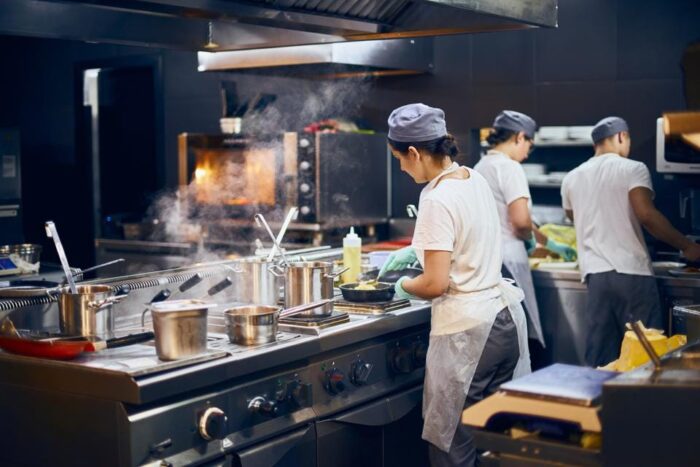
An ever-changing world means an ever-changing restaurant industry. Over the past few years, we may have learned the hard way that it’s impossible to predict the future, but we’ve also learned that adaptability, perseverance, and resilience are strengths that characterize this volatile industry.
While there’s no way of knowing what 2024 might throw our way, there are some trends and changes within the foreseeable forecast that restaurant owners can be prepared for. From new technologies to economic predictions to sways in consumer behaviors, here are the new norms to look forward to in 2024 and how you can maneuver through them toward success.
Food

As restaurant owners, we see economic and social changes in terms of how they’ll affect the food we serve. Since 2020, these fluctuations have greatly influenced the way we prepare, serve, and sell food at restaurants, and though things are slightly different in 2024, there are still some changes to adapt to.
New Ways to Navigate Higher Costs
The pandemic led to an unprecedented hike in food and delivery costs, putting restaurant owners in an uncomfortable vise as they were forced to adjust financial plans and make changes to menus. Unfortunately, food prices will continue to keep a tight grip on restaurant owners in 2024.
While inflation may be predicted to decline gradually over the next year, the costs of ingredients are still expected to rise. Most restaurant owners have had to raise menu prices several times over the last year, and many were forced to do away with pricier dishes that include seafood or exotic ingredients. However, these tactics aren’t sustainable for restaurants whose menus are modeled around more extravagant eats or who rely on being able to offer lower prices.
Aside from slimming portion sizes, shrinking menus, and making price adjustments, many restaurants will begin to implement money-saving practices that don’t infringe on their culinary integrity or upset customers.
One such practice is the use of loyalty programs. Whether via an app or a simple punch card, many major chains and small businesses have started to incentivize customer spending with loyalty-based rewards and promotions. Offering earnable discounts or freebies is a way for restaurants to keep customers coming back even when prices increase.
Other cost-cutting methods that we’ll start seeing in restaurants in 2024 include:
- Adding credit card processing fees onto customer checks
- Going paperless
- Selling merchandise, including apparel or non-perishable foods like packaged desserts or jarred sauces
- Higher delivery fees
Trendy Eats
Menus will change in 2024 because of costs, but they’ll also change as they adapt to consumer preferences and food trends. In 2024, consumers will likely be more health – and environmentally conscious with their dining choices, opting for ethically-sourced ingredients and cleaner, less-processed eats.
Likewise, we’re seeing that social media trends have been infiltrating major restaurant kitchens more and more. As consumers become increasingly reliant on social media, businesses that keep up with social media trends tend to earn popularity points. So, expect to see dinner specials and seasonal menu items that reflect the major trends found on TikTok and other social media sites. Some chains have even begun to add viral, consumer-created secret menu concoctions to their official menus while other restaurants have started making their own versions of trendy dishes like fried chicken sandwiches and charcuterie boards.
The Dining Experience

The recent charcuterie-board fad is a telling one: it signifies a change in consumer dining habits. Think about it — a shareable spread of finger foods would never survive on a menu in 2020. The new norms for the restaurant industry seem to be a mixed bag: consumers are still enjoying pandemic-remnant practices like better takeout programs, and they’re excited to return full-swing to group dining experiences.
Takeout Technology
Of course, takeout wasn’t invented during the pandemic. However, many restaurants developed better takeout programs over the last few years, and many consumers have become accustomed to ordering takeout more than they did before. As such, takeout is here to stay.
The appeal of takeout is its convenience. New technologies like delivery apps, QR code menus, and online payment options have made the ordering and providing takeout much more seamless for customers and restaurants. Likewise, savvy restaurant owners have found that they’re able to use increased prices on third-party delivery apps or for takeout orders, helping them boost profits without too much pushback.
Group Dining and Unique Experiences
A few years of social distancing and eating takeout at home has created a semi-stir-crazy crowd of consumers. And now that concerts and crowd-friendly events have returned, consumers are looking for fun, interactive experiences that provide them with a sense of community. The restaurant industry must now be equipped to provide quality takeout experiences and unique dining experiences now that there is a time and place for both.
In 2024, many restaurants will likely get an interior to revamp to prepare for the full-swing return of in-person dining and group events. Likewise, we’ll see restaurants that provide more than just food to their guests. This might look like renovated outdoor patios, more indoor seating, newer bar spaces, installing televisions or games, or the addition of live performance events.
Labor

When restaurants were deemed essential businesses during the pandemic, the world’s view of food service employees shifted irreversibly. A huge chunk of the restaurant industry’s workforce disappeared to seek jobs with better pay or benefits, leaving countless restaurants understaffed to this day. Hiring and retaining strong teams will be a major focus in the industry in 2024.
Innovative Employee Retention Incentives
Notoriously low wages are associated with restaurant jobs, and the pandemic sparked frustration and downright disapproval of that norm. Now, restaurants whose business models rely on these low wages are struggling to hire and retain skilled, effective teams.
The most obvious solution to this dilemma is to offer higher wages. While some restaurants are increasing pay, they still face the expensive struggle of retention. Hiring and training new employees is very costly, so restaurants in 2024 are predicted to implement retention incentives for employees, including educational opportunities, professional development programs, sign-on bonuses, and even childcare.
Caveats to increasing wages or offering expensive growth opportunities might look like providing more flexible schedules (like Chik-fil-A’s implementation of the four-day workweek) and encouraging tipping in areas where tips were previously nonexistent.
Handling Short-Staffed Shifts
With a smaller talent pool available to them, restaurants have had to adjust their daily operations to accommodate more customers with less staff. They’ve had to rearrange their shift schedules and task delegations in addition to implementing helpful technologies.
In 2024, it’s likely that we’ll see tablets inside more restaurants that allow customers to order themselves without the need for an employee. Likewise, third-party delivery services like Uber Eats and automized reservation managers like Open Table will be used to minimize the number of employees needed on hand.
Consumer-Brand Relationships

The internet has made restaurants more than just places to eat — they’re brands with identities, and consumers are more inclined than ever to actively choose to spend their money with the brands whose values align with their own. Therefore, investing in marketing and public relations management is likely to be a major trend for restaurant owners in 2024.
More Online Interactions
In 2024, restaurants that aren’t already using social media will likely jump on board in a necessary effort to connect with their customers. Consumers use social media to see restaurant menus, find their hours, and get a feel for the brand. This means that it’ll be necessary for restaurants to regularly update their websites and social media pages with business information, pricing, and menus to keep customers satisfied.
Likewise, consumers often directly interact with brands online, whether that means asking questions about allergens or leaving positive reviews. The restaurants that directly interact back are the ones that will be able to build strong, lasting relationships with a loyal customer base.
Brand Persona Becoming Increasingly Important
With so many dining options around, customers don’t necessarily need to choose restaurants for the food or atmosphere. Often, what separates local competitors is their branding, and consumers in 2024 will come to identify brands based on the persona that they portray in person and online.
Whether it be LGBTQ-friendly flags in store windows or fundraising events sponsored by local charities, restaurants will promote their brands to align with their customers’ values. This can also look like using environmentally-friendly practices such as allowing customers to bring their own refillable cups, using recycled containers, or offering plant-based alternatives.
2024 Means Embracing Change and Overcoming Challenges
Strategizing around supply chains, economic fluxes, and labor trends while keeping up with consumer preferences will be on the to-do lists of everyone in the restaurant industry in 2024. Though these hurdles can seem daunting, we’re inspired to remember the long-held tenacity of restaurant owners and employees. Because while challenging volatility often characterizes this industry, the hardy, unrelenting grit with which its workforce perseveres is its crowning attribute.








